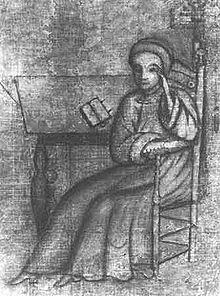Johannes Kelpius
| Johannes Kelpius | |
|---|---|
 |
|
| Born |
January 1, 1667 Schäßburg, Transylvania |
| Died | January 1, 1708 (aged 41) Germantown, Pennsylvania |
| Resting place | Unknown in Pennsylvania |
Johannes Kelpius (1667–1708) was a German Pietist, mystic, musician, and writer, interested in the occult, botany, and astronomy, who came to believe with his followers in the "Society of the Woman in the Wilderness" that the end of the world would occur in 1694. This belief, based on an elaborate interpretation of a passage from the biblical Book of Revelation, anticipated the advent of a heavenly kingdom somewhere in the wilderness during that year. Kelpius felt that the seventeenth-century Province of Pennsylvania, given its reputation for religious toleration at the edge of a barely settled wilderness, was the best place to be. Philadelphia had been founded in 1682, but the city and the Province of Pennsylvania had quickly become a tolerant haven and refuge for many pietist, communitarian, or free-thinking groups who were leaving the Old World for the congenial religious climate of the British colony. Kelpius and his followers crossed the Atlantic and lived in the valley of the Wissahickon Creek in Philadelphia from 1694 until his death. It is reported that they lived communally, though they also spent time in solitary meditation in caves and small cells scattered about their common living quarters. Though no sign or revelation accompanied the year 1694, the faithful, known as the Hermits or Mystics of the Wissahickon, continued to live in celibacy, searching the stars and hoping for the end.
The so-called Cave of Kelpius is located by a small tributary stream of the Wissahickon in Philadelphia's present-day 1,372-acre (5.55 km2) Wissahickon Valley Park, which is part of the 9,200-acre (37 km2) Fairmount Park system of 63 city parks. Though the structure is alleged to be only a springhouse by some, as late as the 1940s it still had a chimney and fireplace, subsequently removed after some vandalism.
Kelpius was born Johann Kelp in 1667, (American documents incorrectly placed his birth in 1673), near the town of Schäßburg, Transylvania (now Sighişoara, Romania) and attended the University of Altdorf, near Nuremberg, where his name was Latinized to Johannes Kelpius according to the custom of scholars of his days. By the age of 22 he had taken a master's degree in theology and published several works, including one in collaboration with Johannes Fabricius. At the university he had been drawn to Pietism, initially a reaction against the formalism of orthodox Lutheranism, but a term that sometimes included various esoteric or heretical Christian ideas. He became a follower of Johann Jacob Zimmermann, a mathematician, astronomer, and cleric, whose pastoral position had ended in 1685 due to his prediction of the imminent advent of a heavenly kingdom, as well as his criticism of the state church. Zimmermann was himself attached to the ideas of the mystic Jakob Böhme. After Zimmerman's sudden death, shortly before the group's departure for the New World, Kelpius became the group's magister or leader.
...
Wikipedia
